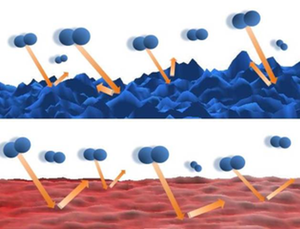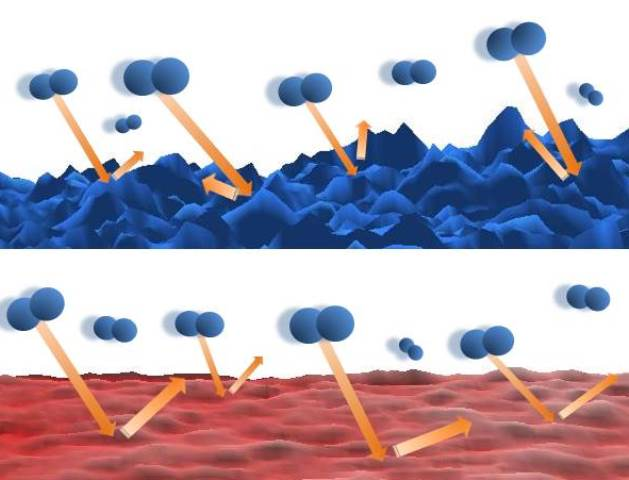Controlling Flow with a Roughness Knob
A newly proposed method for controlling gas flow through tiny devices uses a thin film with an adjustable roughness that would coat the channel walls. In Physical Review Letters, a team reports testing the concept by recording the gas flow between two glass surfaces covered with the film. Temperature-induced changes in the film’s roughness resulted in faster or slower flow. The work suggests that this flow-control concept—which involves no moving parts—could be used to throttle gas through micrometer-wide tubes as part of lab-on-chip systems that can perform complex chemical analyses in a palm-held device. The team is also developing other methods of controlling roughness, such as using electric fields.
When a gas flows in a tube whose diameter is in the micrometer range, the tube walls can have a significant effect because the gas molecules collide with the walls nearly as often as they collide with each other. Collisions with a rough surface will send molecules off in random directions, reducing the forward momentum of the flowing gas. William Ducker of Virginia Polytechnic Institute and State University in Blacksburg, Virginia, wondered what would happen if you could turn the roughness up and down with a knob. “If you have a very narrow channel, you should be able to control the flow by altering the surface layer,” he says, because a smoother channel surface should allow more molecules to bounce off in the forward direction than a rougher surface.
In previous work, Ducker and his colleagues found that placing a thin film on a glass plate could affect the forward momentum for gas flowing over the plate [1]. But films are fairly permanent, so Ducker and graduate student Dongjin Seo have now selected a film that can be adjusted while in place. The film is an organic substance used in the semiconductor industry, and it goes through a kind of melting transition around room temperature. The team expected the material would exhibit significant surface changes in response to changes in temperature.
To test their prediction, Ducker and Seo used a method developed earlier by Ducker and others. They placed a 30-micrometer-diameter glass bead coated with the film material on the end of an atomic force microscope (AFM) probe. The team vibrated the probe and then moved it close to a glass plate that was also coated with the compound. Air forced in and out of the gap by the vibration contributed to the damping force acting on the bead. By measuring this damping, the researchers could calculate the amount of momentum lost by the moving air. Increasing the temperature from 9 to 42∘C, the researchers found that the momentum loss in the flow direction peaked at 18∘C.
The decreasing momentum loss above 18∘C is explained by smoothing of the surface as the film melts, say Ducker and Seo. They confirmed this explanation by using their AFM (this time without the sphere attached) to measure a 750-picometer decrease in surface roughness as the temperature rose from 16 to 41∘C. The team was unable to measure the roughness at lower temperatures, but they speculate that increasing roughness may have little effect once the molecules’ scattering directions become sufficiently random. So the decrease in momentum loss below 18∘C may result from an increase in surface rigidity that allows a colliding molecule to retain more of its energy after each bounce.
The researchers estimate that one could double the gas flow in a micrometer-wide tube coated with their film by raising the temperature from 18 to 40∘C. However, temperature is not an ideal “knob” to use, so Ducker and Seo have recently shown that an electric field can also alter the film roughness and produce a similar effect.
Liquid flows are hardly affected by surface roughness changes, says Elisabeth Charlaix of the University Joseph Fourier in Grenoble, France, so she is impressed by the large effect on air flow produced by “a mere phase change” in a single-layer molecular film. Christophe Horvath of Elvesys, a microfluidic technology company in Paris, says that some advanced lab-on-a-chip devices use a pneumatic network of gas channels to manipulate separate liquid channels [2]. “I am sure that some researchers might be interested in a better control of the pneumatic network,” he says.
–Michael Schirber
Michael Schirber is a Corresponding Editor for Physics Magazine based in Lyon, France.
References
- C. D. F. Honig and W. A. Ducker, “Effect of Molecularly-Thin Films on Lubrication Forces and Accommodation Coefficients in Air,” J. Phys. Chem. C 114, 20114 (2010)
- M. A. Unger et al., “Monolithic Microfabricated Valves and Pumps by Multilayer Soft Lithography,” Science 288, 113 (2000)





